Churches Saint-Mark | Miracoli | Stefano | Zaccaria | Murano | Chorus | Mass Hours
The Church of Santa Maria dei Miracoli - Saint Mary of Miracles' Church in Venice
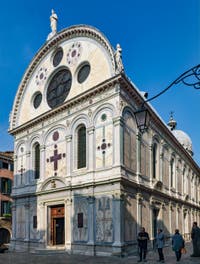
Santa Maria dei Miracoli A Jewel, a masterpiece, a splendour, a sandalwood box, an angel with blond wings, a jewel of the Venetian Renaissance; this little votive church got entitled to all the superlatives since the end of its construction in 1489, and it has them and still deserves them amply.
It all began in 1408 (or 1409) when a wealthy merchant named Francesco Amadi, who devoted complete devotion to the Virgin Mary, had an icon painted in his honour.
Initially, this icon was a triptych, with, in its central part, the Virgin Mary holding the baby Jesus in her arms and, on each side, Saint James and Saint Anthony.
It was long believed that the painter who made it was Master Nicolò, also called Niccolò di Pietro but also Nicolò da Venezia.
Recent research and discoveries make it possible today to say that the actual author of this icon was the painter Jean Charlier, born in France and who became Venetian and took the name of Zanino di Pietro.
The triptych of the Virgin of Santa Maria dei Miracoli
Icon of Virgin Mary This triptych of the Virgin aimed for Francesco Amadi's private use, long before being exhibited in a votive niche at the corner of the Barozzi house contiguous with the Amadi's in Santa Maria Nova.
This votive niche, then lit at night, also acted as street lighting!
The central icon of the triptych quickly became miraculous; miracles, recoveries and other benefits got immediately attributed to it; so it became an object of popular devotion.
As the icon gained value under its growing benefits, a legal challenge ensued between the Amadi and Barozzi families over the icon's property rights.
The families brought quarrel before the authorities, so to end it, they decided to build a temporary chapel, made of wood, so that the faithful could venerate the icon in peace.
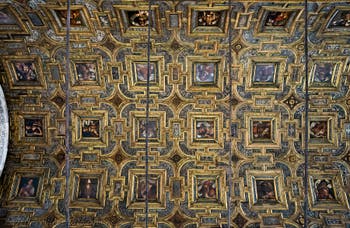
Coffered ceiling of Santa Maria dei Miracoli church They built the present Church of Santa Maria dei Miracoli on the very site of this wooden chapel.
The Miracles
The miracles reached a climax on August 23, 1480, when a man named Francesco Bendi, during a particularly violent dispute with his sister-in-law, tried to kill her with several stabs.Just before returning her soul, the poor dying woman would then have turned, looking at the place of the miraculous icon, imploring the Virgin to her rescue.
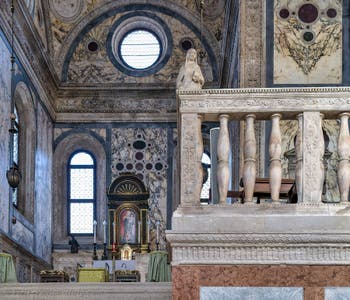
Interior of Santa Maria dei Miracoli Church She was then regaining some strength, screaming so atrociously that the neighbours ran immediately to help her.
But when they arrived at the crime scene, the victim no longer had any marks of injuries, and her clothes were intact!
And all of them shouted: miracle!
Such a miraculous icon, of course, deserved to be sheltered in a holy and consecrated place, worthy of her, so that the faithful could pay her the tribute it deserved and address their prayers to obtain her benefits in return.
The collection of funds became easy, especially since Pope Sixtus IV, in 1477, had officially proclaimed the worship of the Virgin Mary.
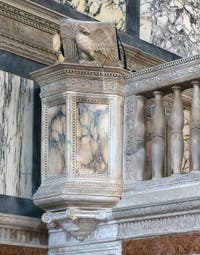
Pulpit S.M. dei Miracoli This small church got dedicated to the Virgin Mary for two reasons, first to give the icon a holy place at the height of its miracles, second, to respond to the religious and papal tendency of the moment.
So, on February 25, 1481, Pope Sixtus IV gave his authorization for the construction of this church dedicated to the Virgin Mary and promised to provide indulgences (namely the temporal remission of the sorrows deserved by sins) to all those who would have donated to the construction of the new church.
With such miraculous, sacred and financial assets at the same time, not only could the Votive Church of Santa Maria dei Miracoli be built quickly, but above all, built with the best and most refined materials possible.
They completed the church in 1489; consecrated it on December 31, 1489, placing the miraculous icon on its altar.
Legend says that the marbles and stones used for the construction and decoration of the Santa Maria dei Miracoli church would be marbles and stones that remained unused during the construction of St. Mark's Basilica.
Santa Maria dei Miracoli Church - Building by one architect: Pietro Lombardo
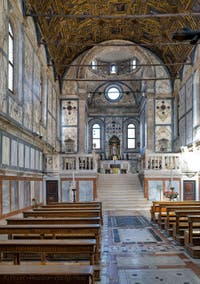
Interior S. M. Miracoli The architect Mauro Codussi had initially developed a project of the Church of Santa Maria dei Miracoli.
But, after the organization of a competition, and in unclear conditions, another architect was in charge of carrying out the church's construction, Pietro Lombardo partly modified Codussi's plans.
Thus, on March 4, 1481, Alvise and Angelo Amadi, descendants of Francesco Amadi, signed a contract with Master Pietro Lombardo to build the church, with the remuneration of 1,000 ducats.
And although the sum was already quite attractive, we must also give Pietro Lombardo a lot of credit because his task was far from easy.
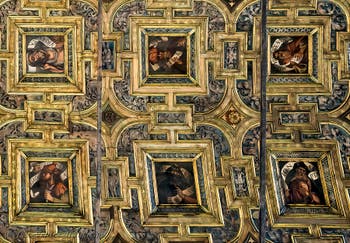
Coffered ceiling of Santa Maria dei Miracoli church Indeed, the land planned to build the future church was particularly cramped, long and very narrow, wedged between the canal and neighbouring houses relatively close.
Pietro Lombardo expressed his talent by managing to overcome these topographic difficulties by using quite ingenious trompe l'oeil effects that give elegance to the whole and even take advantage of the situation of the Church of Santa Maria dei Miracoli along the Rio dei Miracoli.
You can note that the church's external walls present a division into two orders as if it had two floors; one used this device to dress this long and high building and give it a balanced and elegant appearance.
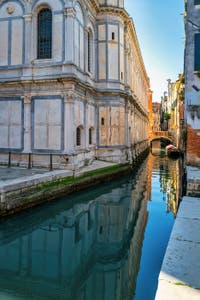
Church and canal Noble materials emphasize this harmonious elegance, Istrian stone and polychrome marbles, including beautiful pink marbles, porphyry and cipolin with concentric veins (cipolin is a light marble formed entangled calcite crystals).
All this was also perfectly staged, superbly positioned by taking advantage of the richness of the materials used without vulgar ostentation. One did not seek to “make rich” but only beautiful.
The decoration of the outer walls and partly the left side wall, which runs along the Rio, was designed with pilasters and friezes to take advantage of the reflections from the canal's water.
Venice is water, and water created Venice, a principle fully respected by Pietro Lombardo in the construction of the Church of Santa Maria dei Miracoli.
As a result, this pretty little church precisely makes you feel its refinement: a jewel, a delicate jewel set between the canal and the street that adjoins it.
This church has another particularity from which it derives its magnificent harmony essentially: it is the work of one man.
In addition to being its architect, Pietro Lombardo was also the sculptor with his sons and his studio.
So much so that he could control the construction as a whole and give it precisely a final look he wanted.
The Main Façade of Santa Maria dei Miracoli Church
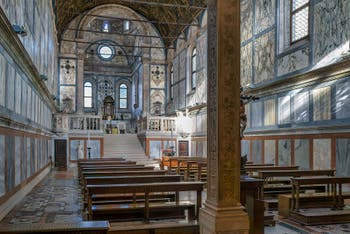
Interior of Santa Maria dei Miracoli Church The main façade is exquisite, with two orders showing a fictional loggia and rounded arches.
At the same time, darker stone pilasters and cornices create a feeling of relief accentuated compared to the light marbles at the bottom.
Above these two orders of the main façade is a large pediment shaped like a half-moon; in its centre is a large rose window framed by three perfectly equidistant oculi.
We also notice two polychrome cabochon hooks, the same we can see on the façade of Palazzo Dario on the Grand Canal.
The resemblance is not accidental since Pietro Lombardo would have been the architect of this charming Venetian palace (there is no certainty on this point).
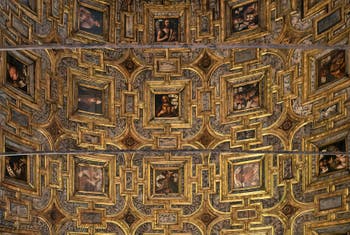
Coffered ceiling of Santa Maria dei Miracoli church At the top of this large circular pediment is a sculpture of a blessing Christ, which Pietro Lombardo could make.
Two angels frame Christ on the outer sides of the pediment.
A bell tower integrated into the church
And as the ground was cramped, Pietro Lombardo was also obliged to build a bell tower integrated into the church itself.This small bell tower of 17 metres, an octagonal “campaniletto”, “little bell tower”, is particularly graceful and adds a little extra touch of refinement to this marvellous little church.
The interior of the Church of Santa Maria dei Miracoli
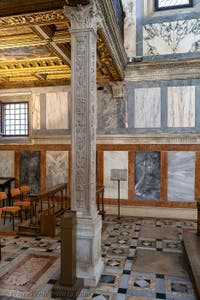
“Barco” S. M. Miracoli When you enter the church, you pass under a “Barco”, a platform intended for the convent's nuns; the convent built simultaneously as the church has given space to dwelling houses.
A suspended gallery directly connected the convent to the Barco of the church.
This Barco lays on four worked and carved pillars where you can see naked mermaids, a somewhat surprising element in a church.
But the theme of Nereids and Tritons had become very trendy in Venice around 1485.
This trend explains their somewhat astonishing presence in this “reliquary” church dedicated to the Virgin Mary.
Numerous paintings of the sixteenth century, of the Titian School, including a Virgin and Child in glory, a Saint Francis and a Saint Clare, decorate the Barco's lower ceiling.
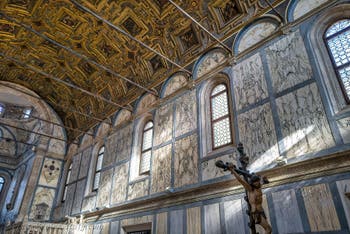
Interior of Santa Maria dei Miracoli Church The nave's ceiling is vaulted in a barrel and covered with fifty great wooden caissons; paintings of Saints and Prophets are in their centre.
These paintings date back to 1528 and were made by Pier Maria Pennacchi with the help of his brother Girolamo, Vincenzo dalle Destre and Lattanzio da Rimini.
As on the outside, polychrome marbles cover the interior walls.
But the most impressive is the choir, strongly raised relative to the level of the basilica-style nave. Thus the choir and the high altar are in whole light, in height and everybody sight.
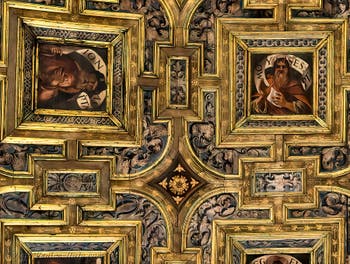
Coffered ceiling of Santa Maria dei Miracoli church This positioning further reinforces the sacredness of the famous miraculous icon on display there, imbued with a soft light that surrounds it from behind, like the halos of sacred light that radiates around the Saints' heads.
This choir is accessed by a wide staircase of fourteen steps, flanked by two grandstands on its left and right, and under which is the Sacristy.
On either side of the staircase, placed directly on the railings, you can admire pretty statuettes representing the Annunciation of the Virgin Mary, the Angel Annunciator, Saint Francis and Saint Clare.
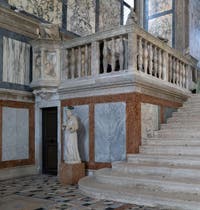
S.M. dei Miracoli These sculptures are by Tullio Lombardo.
A rich set of sculptures, paintings, and marbles ordered and presented in such a way as to form a harmonious ensemble; this gives this church an undeniable charm to which we succumb as soon as we have crossed the threshold.
Church of Santa Maria dei Miracoli: Schedules and Entry Fees
The church of Santa Maria dei Miracoli is in the Cannaregio District, near the Santa Maria Nova Square.The church of Santa Maria dei Miracoli is part of the Chorus project to protect and enhance some Venetian churches; therefore, entrance is not free.
The price of admission is 3€ per person. Free for children under ten years old.
Church Visiting Times of Santa Maria dei Miracoli
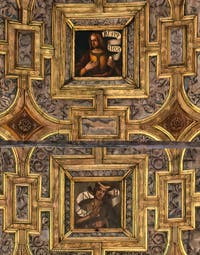
Coffered ceiling Monday to Saturday: 10:00 to 17:00.
The church is open on Sunday afternoon after the service; admission is then free.
If you want to visit several churches of the Chorus Association and if you plan to come to Venice at least twice a year, our advice is to take an annual card (from date to date) with unlimited visits to all the churches run by the association.
The Chorus Association includes the following churches in Venice:
Santa Maria del Giglio,
Santo Stefano,
Santa Maria Formosa,
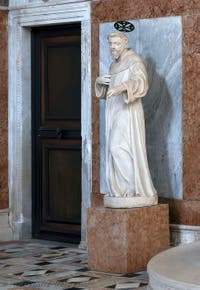
Interior S. M. Miracoli Santa Maria dei Miracoli,
San Giovanni Elemosinario,
San Polo,
Santa Maria Gloriosa dei Frari,
San Giacomo dall' Orio,
San Stae,
Sant'Alvise,
Madonna dell'Orto,
San Pietro di Castello,
Santissimo Redentore,
Santa Maria del Rosario (Gesuati),
San Sebastiano,
San Giobbe.
Churches Saint-Mark | Miracoli | Stefano | Zaccaria | Murano | Chorus | Mass Hours
Back to Top of Page

